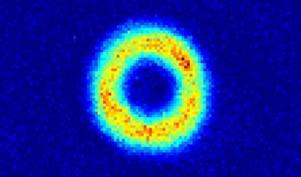In his lab in one of the more venerable buildings at Berkeley Lab, Schenkel and his students have used a focused ion beam to implant single ions in devices mere millionths of a meter square. (An ion is an atom with net charge, typically lacking one or more electrons.)
"Single-atom effects have been observed before, but the yields are so low as to be impractical -- or the devices are randomly formed, with no control or predictability," Schenkel says. "Our approach to single-atom doping integrates ion beams with a modified scanning force microscope. We use the microscope's cantilever tip for both the nondestructive imaging of the target area and to position the ion beam."
The device has the advantage of using virtually any species of atoms, says Schenkel. "We can start with any source of neutral atoms, such as phosphorus or antimony -- manganese is fashionable right now -- and choose one of a number of different sources to ionize them."
The low-energy focused ion beam is sent through a hole in the microscope's cantilever. "The hole in the tip acts as a tiny aperture or mask," says Schenkel. "We've demonstrated holes with diameters as small as five nanometers" -- five billionths of a meter.
To confirm that an ion has been implanted in the silicon, the region is fitted with electrodes to form a transistor channel, placed under a bias voltage. Then the implantation of a single ion -- even in a target area as large as two micrometers on a side (two millionths of a meter) -- can be detected as a change in the resistance of the channel current. Schenkel compares the current to electrons sliding down a hill; the presence of an implanted ion, he says, "is a bump in the way -- it impedes the electron flow."
Says Schenkel, "The method is so sensitive that single-ion hits can be detected at room temperature in a device as large as four square microns. Inside that region we can form numerous single-atom devices, each with dimensions less than 100 nanometers." Before making a specific transistor or other device, single-ion implantation can be "practiced" with atoms of a noble gas that do not dope the substrate. "We wait until the transistor settles down, then switch to the species we want."



